New genetics methods to imp rove the monitoring of water conditions

© Petri Jauhiainen
Modern DNA techniques provide a quick, reliable and cost-effective way of identifying the biota in water courses. The DNA barcoding methods developed and tested by SYKE and its partners are used to produce high-quality monitoring data for the evaluation and classification of the state of waterways. Furthermore, valuable information is gained on species which have been arduous or impossible to identify with traditional methods. Genetic taxa identification methods also support the assessment and protection of biodiversity.
In co-operation:
Norsk institutt for naturforskning (NINA),NTNU Norges teknisk-naturvitenskapelige universitet, Norsk institutt for vannforskning (NIVA), SLU Sveriges Lantbruksuniversitet, Hafrannsóknastofnun, rannsókna- og ráðgjafarstofnun hafs og vatna, Aarhus Universitet, Universität Duisburg-Essen, University of Guelph.
Read more:
SCANDNAnet project
Equality in environmental research

© Pixaby
While the numbers of women working in research and expert positions continue to increase, women are still underrepresented in the most demanding expert positions. This needs to be addressed, as the realisation of equality and non-discrimination is a prerequisite for the widespread utilisation of competence and innovations.
In recognition of this, SYKE and seven other research institutions from five countries bordering the Baltic Sea have developed and trialled new measures for supporting the realisation of equality. These include addressing inequality with the help of peer support networks and by developing management and research practises.
In co-operation:
GEOMAR Helmholtz Centre for Ocean Research Kiel (GEOMAR), Estonian Marine Institute, University of Tartu (UT-EMI), Kiel University (Kiel CAU), Kiel University of Applied Sciences (Kiel UAS), Klaipėda University (KU), Lund University (LU), The Leibniz Institute for Baltic Sea Research, Warnemünde (IOW)
Read more:
Open environmental data for research purposes
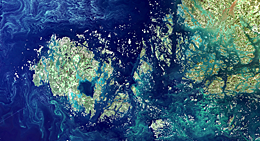
© SYKE/NASA/LC8
SYKE was the first research institute in Finland to open up its data banks to the public. Our metadata services meet the requirements of the Academy of Finland, enabling our data to be widely shared and utilised. All of the open data banks, information systems and metadata maintained by Finland’s environmental administration have been compiled under the web service www.syke.fi/en-US/Open_information. Interest in this material grew greatly during 2016.
Read more:
Curbing of black carbon emissions combats climate change
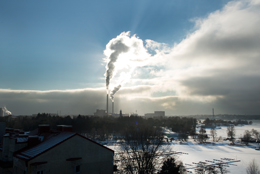
© Riku Lumiaro
Short-lived compounds such as black carbon have a major influence on the warming of the Arctic region. Rapid action to reduce such compounds and CO2 emissions can improve air quality and limit climate change.
SYKE and its research partners have prepared recommendations for curbing black carbon emissions in non-Arctic countries. The Arctic Council will use the results when issuing recommendations on emission reduction. SYKE's strong expertise in modelling the combined effects of air pollution supports climate work in the Arctic region. SYKE has also produced a Policy Brief for decision-makers on black carbon and its importance to climate change.
In co-operation:
University of Eastern Finland, Academy of Finland (Financier)
Read more:
Researchers demonstrated a connection between climate change and flooding

© Ari Andersin
A large international team of researchers, in which SYKE was represented as well, demonstrated a connection between flooding and climate change for the first time across Europe. Floods in recent decades have clearly occurred earlier in certain regions in Europe due to global warming and, on the other hand, have been delayed in certain areas. A study conducted by the Vienna University of Technology analyzed data from more than 4000 hydrological observation stations in 38 European countries from 1960 to 2010.
The article, which also utilized records from long and continuous hydrological observations in Finland, was published in August 2017 in the Science journal.
Read more:
Aranda model utilised around the world
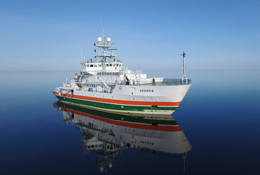
© Panu Hänninen
The outstanding model of SYKE's marine research vessel Aranda has been used around the world in the planning of research vessels. Aranda's special techniques for studying the food webs of the Arctic regions and seas are utilised around the world. Aranda is used in research by the Finnish Meteorological Institute, the Natural Resources Institute Finland, as well as the Swedish Meteorological and Hydrological Institute (SMHI). Cooperation with neighbouring countries helps unify and develop follow-up methods and in conserving resources.
In co-operation
Finnish Meteorological Institute, Natural Recources Institute Finland, and Swedish Meteorological and Hydrological Institute (SMHI).
Read more:
Air pollution estimates target emission reductions worldwide
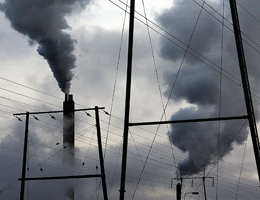
© Jouko Lange
Air pollution affects the climate, the environment and human health. SYKE has been involved in developing European and global air pollution emission estimates in cooperation with the IIASA Institute based in Austria.
The models have enabled the cost-effective targeting of emission reduction. They enable estimates of how a number of emissions travel in the atmosphere, their impacts, and the potential and costs of emission reductions. The results of the work are also used in the preparation of legislation, in support of regional planning, and in the evaluation and follow-up of the obligations of international treaties.
In co-operation:
IIASA Institute
A modern marine research vessel for Namibia

© Juha Flinkman
The Namibian government acquired its first modern marine research vessel from Finland. SYKE Marine Research Centre provided training for the National Marine Information and Research Centre (NatMIRC) in the scientific use of the new vessel. The expertise of Namibia's marine scientists improved, particularly in the modelling of marine ecosystems and the application of geographic information systems (GIS) related methods in marine research. In addition, communications experts from SYKE improved the partner organisations’ skills in preparing and using communications strategies and materials.
In co-operation:
National Marine Information and Research Centre (NatMIRC), Ministry for Foreign Affairs of Finland (Financier)
Read more:
Remote sensing is used to monitor the state of the environment
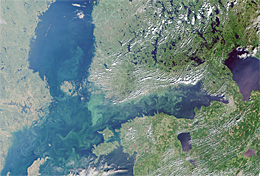
© ESA Copernicus Sentinel 3, processing SYKE.
The satellite data produced by SYKE is used extensively to monitor the state of the environment. Authorities, citizens and the national media alike can follow the recorded daily changes in water quality in surface water areas through SYKE’s TARKKA and PINTA services.
One of the most eagerly followed topics is the status of the blue-green algae blooms in Finnish coastal waters and lakes during the summertime. Other popular topics include surface water temperatures, ice melting and the impact of river waters on the coastal areas. SYKE’s STATUS information system is directed at authorities and is used for official evaluations of the state of the environment.
Read more: